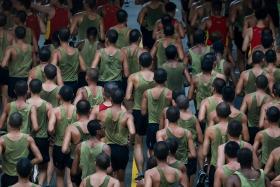SAF’s Digital and Intelligence Service to safeguard S’pore against digital threats
The Digital and Intelligence Service (DIS), the Singapore Armed Forces’ fourth arm, was established on Friday to provide timely intelligence and safeguard Singapore against digital threats, including cyber attacks and electronic warfare.
The DIS will be made up of four main units, called commands. These are in the areas of intelligence; C4 (command, control, communications and computers) and cyber; electronic protection and psychological defence; and training.
Under its purview is also a centre of excellence to develop digital expertise with external parties such as government agencies, universities and industry experts, as well as a service headquarters similar to those found in the army, navy and air force.
President Halimah Yacob appointed the first Chief of DIS, Brigadier-General Lee Yi-Jin, at the service’s inauguration parade at the Safti Military Institute in Jurong, where the DIS’ crest and flag were unveiled.
She also conferred state colours to the fledgling service, meant to provide identity and pride among its servicemen and women. The event was attended by about 800 senior defence officials and invited guests.
In a speech, Madam Halimah said the DIS’ formation was timely and necessary for the SAF to adapt itself against security threats in the digital and information domains.
She highlighted the threat of hybrid warfare, where digital attacks by state and non-state actors can result in disruption of essential services and local elections, as well as theft of data.
“Just as the SAF defends Singapore in the air, land and sea, the fourth service will provide us the capabilities to defend ourselves against attacks in the digital domain,” she said.
She urged the DIS’ servicemen and women to embody the same pioneering spirit as their predecessors in the SAF. “Strive for technical and operational excellence, while staying true to the SAF core values and ethos. These will be key to your enduring success as a service.”
DIS personnel on parade were decked out in their No. 1 ceremonial uniform with grey pants and berets - the same colour as the background for the DIS flag, meant to symbolise the steadfast resolve of the service in supporting the SAF’s operations.
Announced in March, the DIS consolidates cyber and C4I (command, control, communications, computers and intelligence) units that have been formed over the last decade under a unified structure.
Unveiling its organisational structure for the first time, the Ministry of Defence said the DIS will consist of the Joint Intelligence Command, the C4 Command/Cybersecurity Task Force, the Digital Defence Command, the DIS Training Command and a Digital Ops-Tech Centre.
The commands consist of existing and reorganised SAF outfits, as well as new ones such as the Digital Defence Command and the DIS Training Command, which is expected to be set up in 2023.

Speaking to reporters at a briefing on Wednesday, head of the DIS Implementation Office, Colonel Letchumanan Narayanan, said military regulars under the Military Domain Experts Scheme will form the core of the new service.
Defence Executive Officers, who are civilians, will also contribute expertise in areas including cyber, policy formulation and operating and maintaining networks.
Full-time national servicemen will be deployed based on their aptitudes, such as in imagery analysis or open-source research, said Col Letchumanan, who declined to reveal the size of the new service due to operational sensitivities but said there was still a need for more headcount.
He said the DIS’ capabilities are not about hardware such as tanks, fighter jets or warships.
“We can talk about servers and networks, but the real capabilities are people. That is one of the major reasons behind having a service - to allow us to recruit, retain and build the right people,” he said.
Get The New Paper on your phone with the free TNP app. Download from the Apple App Store or Google Play Store now

